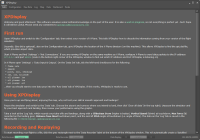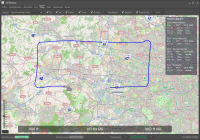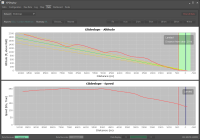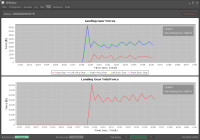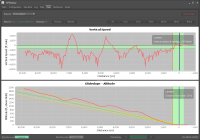Laminar Research make an excellent flight simulator called X-Plane. XPDisplay is a free desktop application that can run on the same computer as X-Plane, or a different computer (for example a spare laptop) on your home network.
With XPDisplay, you can:- View your flight on a moving map display (showing other aircraft, your flight path, position of airports and runway information)
- Log your flights (takeoffs and landings)
- View raw data from X-Plane
- Graph your glideslope descent, vertical speed, and landing gear forces
- Test your skill at smooth approach and landings, with metrics such as: vertical speed on touchdown, distance from ideal landing point, glideslope score (smoothness of descent), max landing gear force
- Record and replay your flight data
If you have any improvements or comments that you'd like to contribute, please email me at:

Requirements
X-Plane needs to be version 9 or above.The computer that you run XPDisplay on needs to be networked to the computer running X-Plane. XPDisplay runs on Windows, Linux or Mac. XPDisplay is written in Java, so you need to have Java 6 or above installed on your computer - read on for details.
Download
- Do I have Java?
- Get Java (you'll need the JRE edition, Java 6 or above)
- Download XPDisplay-20161016-150922.tar.gz (8.4M)
Getting it running
- Download the XPDisplay tar.gz file (above).
- Extract it (either using WinZip, 7-zip, or 'tar xvzf
' from the command line) - Run the 'run.bat' file (windows) or 'run.sh' (Mac OSX or Linux - you might need to make the run.sh file executable with 'chmod u+x run.sh' first).
- If that doesn't work, open a command prompt and 'cd' to the folder where you downloaded the JAR.
- Type '
java -Xmx256m -jar XPDisplay.jar' (without the quotes) - After a short pause, XPDisplay should appear
Configuring X-Plane
Excellent, you've done the hard work. Fire up X-Plane on your main computer and follow the instructions on the XPDisplay Intro screen:1. Select 'Settings' then 'Net Connections' from the menu:

2. On the 'Data' tab, make sure the details in the box are the same as those shown in the bottom-right of XPDisplay:

3. Close that window, then from the menu, select 'Settings' then 'Data Input & Output':

4. On the 'Data Set' tab, make sure 'Internet' is enabled in the top-right, then tick the left-most column of any values you wish XPDisplay to show:
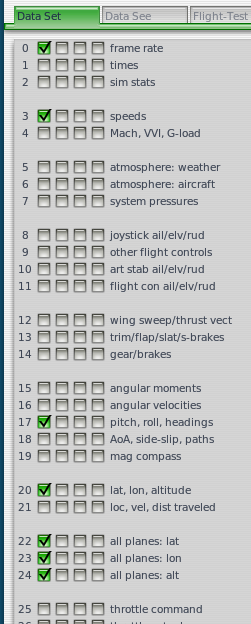
(please note that XPDisplay currently only handles those shown as ticked)
5. XPDisplay should then begin to display the data. If you have problems, check that the computer on which XPDisplay is running is connected to your network.
Enjoy!
Source code
The source code is now available as a project on Github.If you have any questions about the source code, please contact me at:

Frequently-Asked Questions
Q: Why don't you implement X?A: That's (probably) a great idea! Before you drop me an email, please check that X-Plane can provide that kind of data via the Data Output screen, and have a good long think about exactly how the feature would work. I might be slow to respond to emails, but I'm open to ideas!
Q: Why doesn't XPDisplay show X?
A: If X-Plane can send the data, then theoretically XPDisplay could show it. Please feel free to download the source and try changing it. :-)
Q: Isn't this cheating?
A: Yes! Wholeheartedly! If you are a big fan of simulator realism then you'd probably want to avoid using XPDisplay. If, however you want to fly a realistic simulator, but with the aid of an extra display to make fly-ins easier, then XPDisplay can help.
Q: What's with the funky colours on the Dashboard screen?
A: Hopefully a more dangerous value is associated with a more dangerous-looking colour, to attract your attention. It's not perfect, but it's a start.
Q: My radar and map do not display other aircraft. Is this a bug?
A: It might be a bug in X-Plane. Set everything up, then go to X-Plane's data input/output settings page and first change the UDP data rate slightly, then untick the three 'other planes' checkboxes, from top to bottom. Then tick them again from bottom to top. This seems to work.
Q: Why does the Dashboard time display in GMT, not my local time zone?
A: Fly-ins are organised in GMT.
Q: What is IAS / TAS / AGL / AMSL?
A: IAS is Indicated Air Speed (IAS), as shown in the cockpit. This might be different to your True Air Speed (TAS) if you are flying through a headwind / tailwind. AGL is your altitude Above Ground Level, as opposed to your altitude Above Mean Sea Level.
Q: What's with the FL values on the Map and Radar screens?
A: They are Flight Levels - altitude in multiples of 100 feet. FL350 is therefore 35,000ft.
Q: The radar screen looks wrong. What's up?
A: This screen has north at the top and displays aircraft positions from their latitude and longitude. There may be a bug in the lat/long maths in XPDisplay, therefore making the screen distort at high latitudes. The radar screen also auto-scales, so the distances are all relative.
Q: Why are other aircraft displayed as #1, #2 etc?
A: X-Plane doesn't expose their tail numbers or ICAO codes (aircraft type) over the network, so XPDisplay can't display anything useful.
Q: Have you thought of writing a plugin for X-Plane?
A: Yes. I've tried writing a plugin with an integrated JVM, but haven't had much success getting a working build environment up and running. Maybe in the future?
Q: I have multiple monitors. How do I run XPDisplay on the same machine as X-Plane?
A: You will need to tell X-Plane to send data to port 49001 rather than 49000 on X-Plane's 'Data' tab, and use that same port number when starting XPDisplay:
e.g. 'java -Xmx256m -jar XPDisplay.jar 49001' (without the quotes)
Q: No data seems to be coming through to any of the screens. What could I have done wrong?
A: First, check that the 'raw data' screen isn't displaying any data. If that's blank then the data simply isn't getting through to XPDisplay. Go back through the instructions and check that the right boxes in X-Plane are ticked, and that the 'Data' tab has the right IP address and port for your XPDisplay machine. Try 'pinging' one machine from the other (see Google for how to do this). Check firewall settings on the XPDisplay machine aren't blocking port 49000. Check that you're running X-Plane 9 (or greater).
If there are still problems and you're trying to get XPDisplay working on the same machine as X-Plane, try specifying 127.0.0.1 as the IP address from the command-line:
e.g. 'java -Xmx256m -jar XPDisplay.jar 49003 127.0.0.1' (without the quotes)
.. and the same in X-Plane ('Settings' -> 'Net Connections' -> 'Data' tab).
Q: Is XPDisplay certified for official FDM (Flight Data Monitoring) use?
A: No. Please use XPDisplay for fun, to improve your flying and your experience with X-Plane, but it is not suitable for use with real flights and official pilot training.
(c) Duncan Jauncey, 2009-2016
